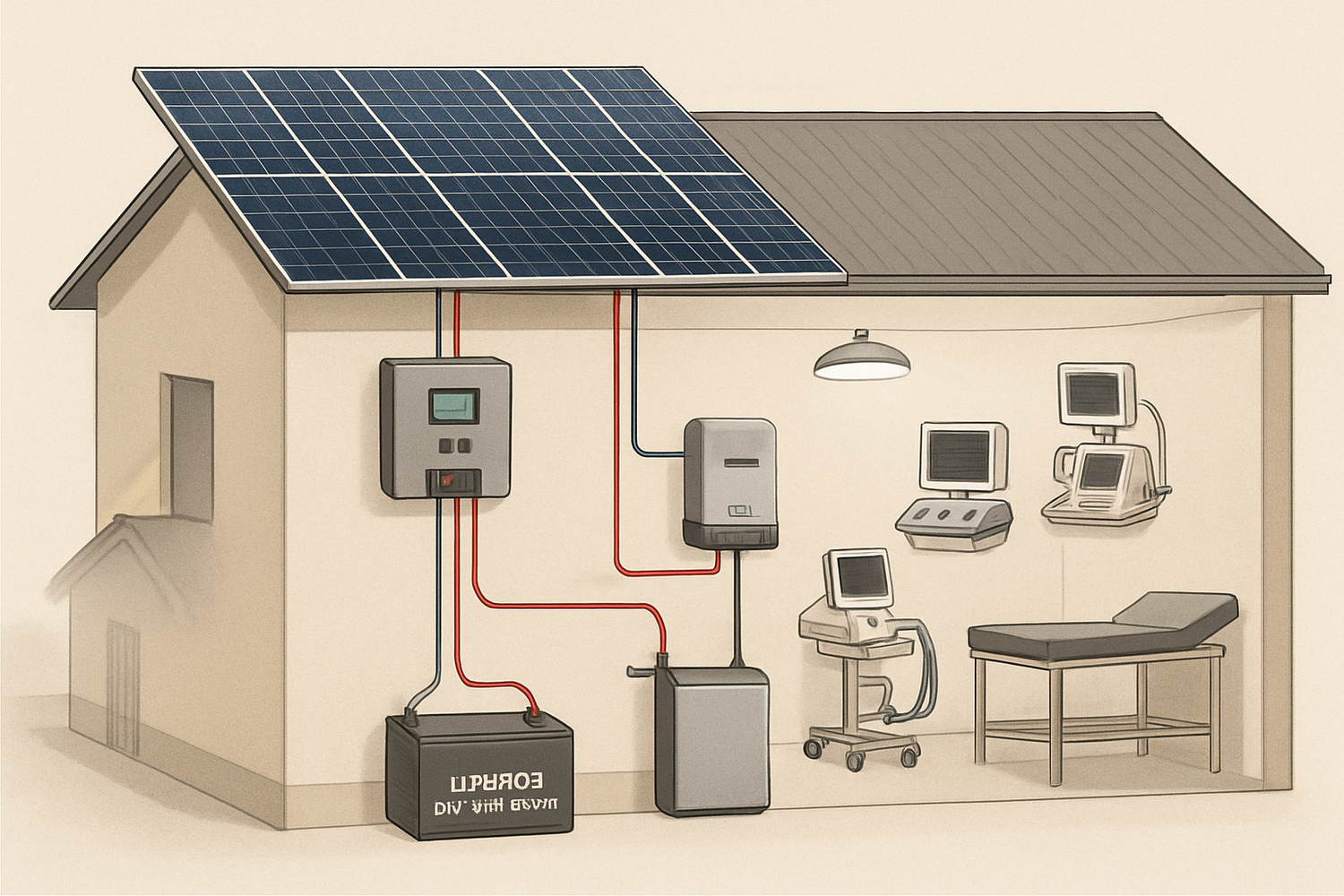Access to reliable electricity remains a significant challenge for many remote communities. This lack of consistent power directly impacts essential services, especially healthcare. Imagine a clinic needing to store life-saving vaccines or power critical medical equipment without a dependable energy source. Solar mini-grids, particularly those powered by advanced lithium iron phosphate (LiFePO4) batteries, offer a robust and sustainable solution. This article guides you through designing such a system, focusing on practical steps and technical considerations to ensure clinics receive the uninterrupted power they need.
The Urgent Need for Reliable Power in Remote Healthcare
Energy Access Challenges in Underserved Areas
Millions of people globally still lack access to modern energy services. Remote and rural areas often remain unconnected to national grids due to high infrastructure costs and sparse populations. This energy deficit creates a cycle of underdevelopment, hindering progress in various sectors, including healthcare. Decentralized renewable energy (DRE) solutions, such as solar mini-grids, have emerged as a viable alternative for these regions. The International Renewable Energy Agency (IRENA) estimates that in 2016, approximately 133 million people accessed electricity services using off-grid renewable energy solutions, with at least 9 million connected to mini-grids.
Impact on Healthcare Delivery and Community Well-being
Clinics in off-grid locations face immense operational hurdles. Without consistent electricity, basic services like lighting for night-time emergencies, refrigeration for medicines and vaccines, and power for diagnostic equipment become impossible. This directly compromises patient care and limits the scope of medical services offered. Reliable power from a mini-grid can transform these facilities, enabling extended operating hours, improved diagnostic capabilities, and proper storage of temperature-sensitive supplies. This, in turn, enhances public health outcomes and significantly improves the overall well-being of remote communities. Bringing Electricity to Remote Areas through Mini-Grids and Solar Home Systems highlights how electricity access empowers medical equipment in rural clinics.
Why LiFePO4 Batteries are Ideal for Clinic Mini-Grids
Advantages of LiFePO4 Technology
LiFePO4 (Lithium Iron Phosphate) batteries are a superior choice for off-grid solar systems, especially for critical applications like clinics. They offer several compelling advantages over traditional battery chemistries. LiFePO4 batteries typically boast a long cycle life, often exceeding 2,000 to 5,000 cycles, meaning they can last for many years and reduce the need for frequent replacements. They also allow for a high depth of discharge (DoD), safely discharging down to 80% or even 90% of their capacity without damage, which provides more usable energy. Their charge and discharge efficiencies are high, often ranging from 95% to 98%, ensuring more of the generated solar energy is utilized.
Safety is a paramount concern in healthcare facilities, and LiFePO4 batteries excel in this regard. They are considered among the safest lithium battery chemistries due to their enhanced thermal stability, making them less prone to thermal runaway and fire compared to other lithium types. Furthermore, they contain no toxic materials like lead or cobalt, making them environmentally friendlier. These batteries require minimal maintenance compared to lead-acid batteries, which often need regular checks and water refills. Their lightweight and compact design also simplifies installation and reduces space requirements.
Key Technical Specifications for Selection
When selecting LiFePO4 batteries for a clinic mini-grid, consider several technical specifications. The nominal voltage (e.g., 12V, 24V, 48V) must match your inverter and system design. Capacity, measured in Ampere-hours (Ah) or kilowatt-hours (kWh), dictates how much energy the battery bank can store. The C-rate indicates the rate at which a battery can be charged or discharged relative to its maximum capacity; a higher C-rate allows for faster energy delivery. Additionally, pay attention to the operating temperature range, ensuring the batteries perform reliably in the local climate conditions. Battery Management Systems (BMS) are crucial for monitoring and protecting the battery bank, managing cell balancing, overcharge/discharge protection, and temperature control.
Designing Your Clinic's LiFePO4 Solar Mini-Grid
Comprehensive Load Assessment and Energy Demand
Precise system design begins with a thorough load assessment. You must identify every electrical device the clinic uses, including lighting, refrigerators for vaccines, medical equipment (e.g., microscopes, sterilizers), and administrative electronics. For each device, determine its power rating (watts) and estimated daily usage hours. Multiply these to calculate daily watt-hours (Wh) for each item, then sum them for the total daily energy consumption. This baseline is critical for accurate system sizing. Mini-Grid Sizing emphasizes that adequate load assessment and demand forecast are essential for appropriate mini-grid design. Consider peak loads, such as when multiple high-power devices operate simultaneously, to ensure the inverter can handle the demand. A wrongly configured system, either too small or too large, will either fail to serve its purpose or struggle to recover costs.
| Device | Power Rating (Watts) | Daily Usage (Hours) | Daily Energy (Wh) |
|---|---|---|---|
| LED Lights (5 units) | 50 (10W each) | 10 | 500 |
| Vaccine Refrigerator | 100 | 24 | 2400 |
| Microscope | 20 | 4 | 80 |
| Sterilizer | 1500 | 1 | 1500 |
| Laptop/Charging Station | 60 | 8 | 480 |
| Water Pump (intermittent) | 300 | 2 | 600 |
| Estimated Total Daily Consumption | 5560 Wh | ||
Core System Components and Architecture
A typical LiFePO4-powered solar mini-grid for a clinic comprises several key components working in concert. Solar photovoltaic (PV) panels convert sunlight into direct current (DC) electricity. Choose high-efficiency panels designed for durability in varying weather conditions. Charge controllers regulate the voltage and current from the solar panels to the batteries, preventing overcharging and optimizing charging efficiency. MPPT (Maximum Power Point Tracking) controllers are generally preferred for their higher efficiency. Inverters convert the DC electricity from the batteries into alternating current (AC) for standard clinic appliances. Pure sine wave inverters are crucial for sensitive medical equipment. The LiFePO4 battery bank stores excess energy for use during periods without sunlight. Balance of System (BOS) components include wiring, circuit breakers, fuses, and mounting structures, all essential for safety and efficient operation.
Sizing the Solar Array and Battery Storage
Sizing the solar array and battery bank requires careful calculation to ensure continuous power. For the solar array, consider the total daily energy consumption, local peak sun hours, and system efficiency losses (inverter, battery charge/discharge, wiring, temperature, dust). A common formula involves dividing daily load by peak sun hours and system efficiency. For example, if a clinic consumes 5,560 Wh daily, with 4.5 peak sun hours and an 80% system efficiency, a solar array of approximately 1,544W would be needed (5560 Wh ÷ 4.5 hours ÷ 0.80 = 1544W).
Battery bank sizing depends on the daily energy consumption and the desired autonomy (how many days the system can run without solar input, e.g., during cloudy weather). Given the high DoD of LiFePO4 batteries, you can utilize a larger portion of their stated capacity. For a 5,560 Wh daily load and 2 days of autonomy at 80% DoD, you would need a battery bank with a usable capacity of 11,120 Wh, translating to a total nominal capacity of approximately 13,900 Wh (11,120 Wh / 0.80). Electricity Storage Valuation Framework notes that mini-grids with storage capacity can significantly reduce fossil fuel consumption and increase renewable energy share, aiding the transition to 100% renewable electricity generation in off-grid areas.

Implementation, Operation, and Long-Term Sustainability
Installation Best Practices and Safety
Professional installation is crucial for the safety and longevity of a clinic mini-grid. Ensure all electrical work adheres to relevant national and international standards. Proper grounding of the system protects against electrical surges and lightning. Secure mounting of solar panels prevents damage from strong winds. For battery installations, ensure adequate ventilation and protection from extreme temperatures. Always prioritize fire safety measures, especially around the battery bank and inverter, and provide appropriate fire suppression equipment.
Monitoring and Remote Management for Off-Grid Systems
Implementing a robust monitoring and management system is vital for off-grid clinics. These systems provide real-time data on energy production, consumption, and battery state of charge. Remote monitoring allows technicians to detect performance issues, identify potential faults, and even control certain aspects of the system without needing to be physically present. This capability is particularly valuable in remote locations, reducing response times and operational costs. The U.S. Department of Energy (DOE) has supported the development of tools that connect and coordinate multiple microgrids, enhancing community resilience and reducing reliance on backup diesel generators. Success Story—New Tool Connects Multiple Microgrids to Increase Community Resilience highlights how solar-plus-storage microgrids enable independent operation during outages.
Maintenance for Continuous, Reliable Operation
Regular maintenance ensures the long-term reliability and efficiency of your LiFePO4 mini-grid. Clean solar panels at least once a month, or more frequently in dusty environments, to remove dirt and debris that can reduce efficiency. Inspect panels for any physical damage. For the battery bank, regularly check terminals and connections for corrosion and tightness. LiFePO4 batteries are low maintenance, but visual inspections remain important. Test inverters and charge controllers monthly to ensure proper function, looking for error codes or signs of overheating. Keep the system area clean and free from obstructions. Proactive maintenance extends the lifespan of components and prevents costly downtime, which is especially critical for a healthcare facility.
Empowering Healthcare with Sustainable Energy
Designing and implementing a LiFePO4-powered solar mini-grid offers a transformative path for remote clinics. It moves beyond unreliable power sources, providing consistent, clean, and sustainable energy. This energy independence directly translates to improved healthcare services, better patient outcomes, and enhanced community resilience. By carefully assessing energy needs, selecting appropriate LiFePO4 technology, and committing to proper installation and maintenance, you can establish a robust power system that empowers healthcare providers to deliver essential services, even in the most challenging environments.
Frequently Asked Questions
What is a LiFePO4 mini-grid?
A LiFePO4 mini-grid is a localized power generation and distribution system that operates independently from a main electrical grid. It primarily uses solar panels to generate electricity, with LiFePO4 (lithium iron phosphate) batteries for energy storage. This setup provides reliable, sustainable power to a cluster of buildings, such as a remote clinic and surrounding facilities.
How long do LiFePO4 batteries last in a mini-grid?
LiFePO4 batteries are known for their exceptional longevity. In a well-designed and properly maintained mini-grid system, they can last for 10 to 15 years or even longer, often providing 2,000 to 5,000 charge and discharge cycles. This extended lifespan significantly reduces replacement costs and maintenance efforts compared to other battery types.
Can a solar mini-grid power critical medical equipment 24/7?
Yes, a properly sized solar mini-grid with adequate LiFePO4 battery storage can reliably power critical medical equipment 24/7. The design must account for the clinic's total energy demand, including peak loads, and ensure sufficient solar generation and battery autonomy to cover periods without sunlight or during high demand. This continuous power is crucial for vaccine refrigeration, lighting, and life-saving devices.
What are the main steps in designing a clinic solar mini-grid?
The main steps involve conducting a detailed load assessment to determine the clinic's energy needs, selecting appropriate solar panels and LiFePO4 batteries, sizing the solar array and battery bank based on energy demand and desired autonomy, choosing suitable inverters and charge controllers, and designing the distribution network. Proper installation, monitoring, and regular maintenance are also critical for long-term success.





Leave a comment
All comments are moderated before being published.
This site is protected by hCaptcha and the hCaptcha Privacy Policy and Terms of Service apply.